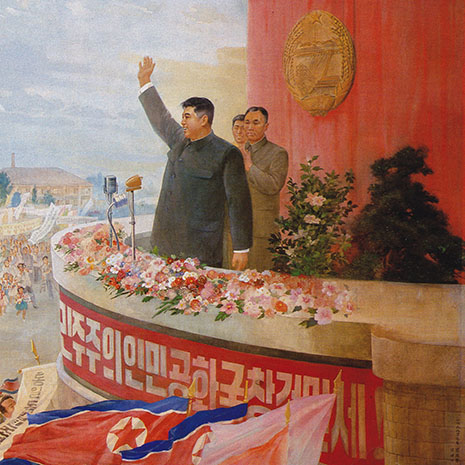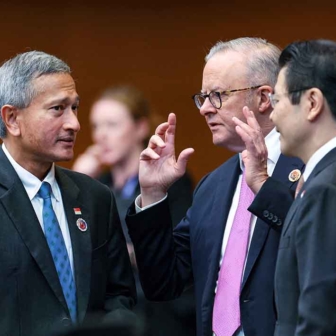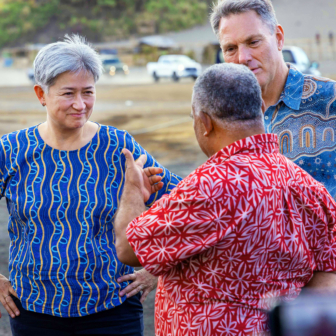The Cleanest Race: How North Koreans See Themselves – and Why It Matters
By B.R. Myers | Melville House | $36.95
North Korea is a unique country in world politics, about which so much and yet so little is said. The same “facts” are rolled out repeatedly – the ongoing nuclear standoff, sporadic disputes with South Korea and the United States, its entry into George W. Bush’s “axis of evil” – and yet we know precious little about the country itself and its people. What is life actually like in North Korea? What do North Korean people really think? What, despite its many failings, still holds this country together?
One step down the long road of trying to understand North Korea is to read the state’s propaganda. In this rather unusual book, B.R. Myers has done precisely that. Drawing on the extensive collection of North Korean propaganda materials available in the Unification Ministry of South Korea, he charts a path through posters, nightly news reports, television dramas, short stories, cartoons, history textbooks and even dictionaries in an effort to capture what he calls the “Text” – the official culture and myths surrounding the North Korean leadership, the Workers’ Party and the state. The results are provocative and insightful.
The first and most important insight is simply that propaganda matters. Myers properly focuses on Korean-language propaganda aimed at the domestic audience, taking to task Western analysts who simply assume that the English-language bombast aimed at the international community mirrors domestic propaganda. The resources dedicated to this domestic propaganda, the diversity of sources in which it appears, and the continuity of a single storyline all suggest that the North Korean leadership is convinced that such domestic propaganda plays a key role, perhaps the key role, in sustaining their distinct social, political and economic system.
What, then, is in this propaganda? What are people told? Above all, Myers tells us, the Text treats the North Korean people as children under “the loving care of the Leader.” Myers provides an unexpected gendered reading of North Korean propaganda. Kim Il Sung, the regime’s founder, is presented as a gentle, caring, paternal figure while his son Kim Jong Il often takes on a maternal image. Party officials, in the words of a North Korean dictionary, “must become mothers who ceaselessly love and teach the Party rank and file.” The propaganda, Myers argues, aims to create a sense of warm protection for the people, a sense that they are safe and cared for in this all-enveloping state and society.
Myers also reads the Text as a race-based nationalism. He thus rejects the significance of traditional Confucian ideology, Marxism and the rhetoric of self-dependence that is part of the state ideology, Juche, instead suggesting that North Korean propaganda tells a tale of racial purity. The North Korean people are the “real” Koreans, unlike their polluted South Korean brothers and sisters. This also implies a kind of naivety or innocence – hence the childlike images and the need for protection by the leadership. Ironically, such “blood-based nationalism” is most similar to Japanese colonial propaganda, which also presented a historical story of the Japanese people as inheritors of an unbroken chain of Japanese cultural and racial purity.
While I’m sympathetic to Myers’s efforts to provide a new reading of North Korean propaganda and grateful for his extensive research into previously untapped materials, I find this a frustrating book. Often, the presentation of the Text is not drawn from actual quotes (with proper citations to the original), but instead relies on Myers’s own reinterpretation in what he assures us is a faithful rendering of an otherwise unintelligible and overly verbose prose. Perhaps, but most readers might prefer to have the original so they can make their own decisions.
More disconcerting is the scarcity of comparisons to other authoritarian states. Myers quickly dismisses the obvious comparisons with propaganda from China’s Cultural Revolution, yet in fact the techniques of mobilisation, the disconnect from economic reality and the lionising of a single leader all echo Maoist China directly. Before asserting the unique character of North Korean propaganda, a reading of recent studies of the role of propaganda in Syria, Iran and Soviet Russia would have been useful. Most surprisingly, given Myers’s repeated insistence on the importance of nuances within the Korean language, there is scant engagement with South Korean scholarship on these questions.
The source of my greatest disappointment is the absence of information about how the propaganda actually matters. How do ordinary North Koreans perceive it? The book’s title promises to tell us “how North Koreans see themselves” and yet we are provided almost no information on the reception side of propaganda. Potential resources do exist. Discussions with official interlocutors within North Korea, interviews with the massive refugee community in South Korea and China and with NGOs and government officials with long experience living in North Korea, personal observations on visits to North Korea, and South Korean news and reports could all provide some insight into how people seem to respond to this propaganda. Yet Myers avails himself of almost none of these resources. As a result, his assertion that “the Koreans believe that their childlike purity renders them so vulnerable to the outside world that they need a Parent Leader to survive” rings hollow.
The second part of the title – “and why it matters” – refers to Myers’s claim that the rigidity and significance of domestic propaganda impedes the North Korean leadership from compromising with the United States and South Korea in exchange for economic assistance and diplomatic ties. Yet Myers also points out that given the United States’ role in the propaganda as the useful eternal enemy, “America’s friendship would be… more dangerous than its enmity.” The policy prescription would seem to be diplomatic and economic engagement, something many North Korean experts in the United States have been urging for years. We are thus left with a confusingly mixed message about where to go from here.
Finally, and most discouragingly, Myers’s book fails to capture the basic humanity of the people living north of the thirty-eight parallel. Having visited North Korea six times and worked closely with North Korean partner organisations for years, I understand how difficult it can be to try to break through to the “real” people in North Korea. Yet if we hope to understand North Korea, we must find ways to tell their stories. Unfortunately, we’re not there yet. •




